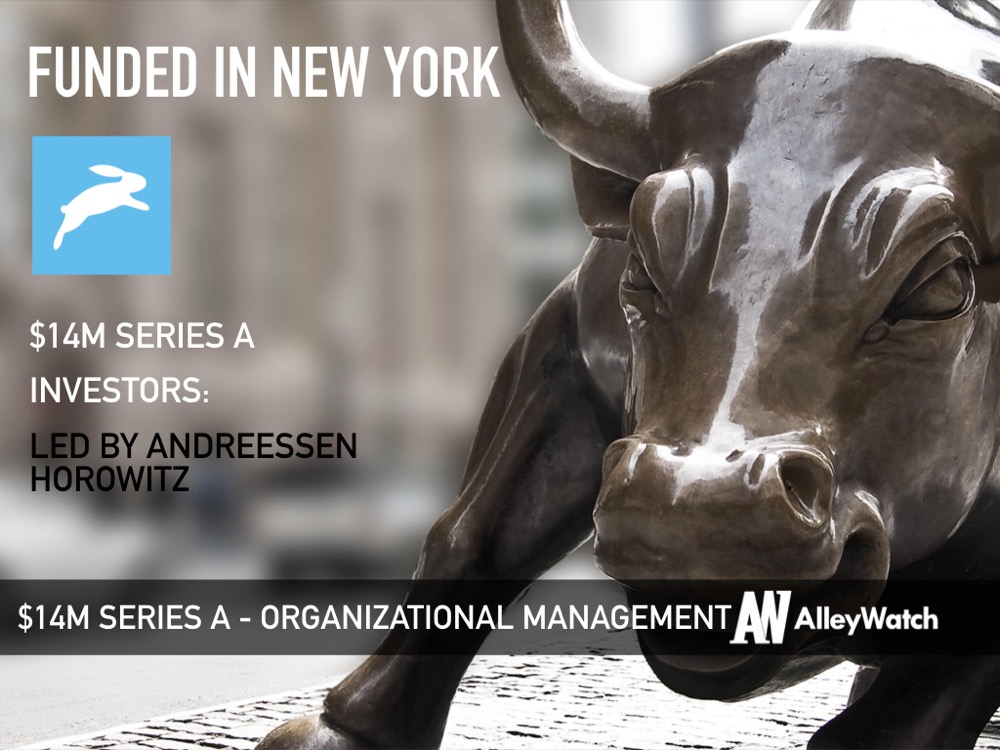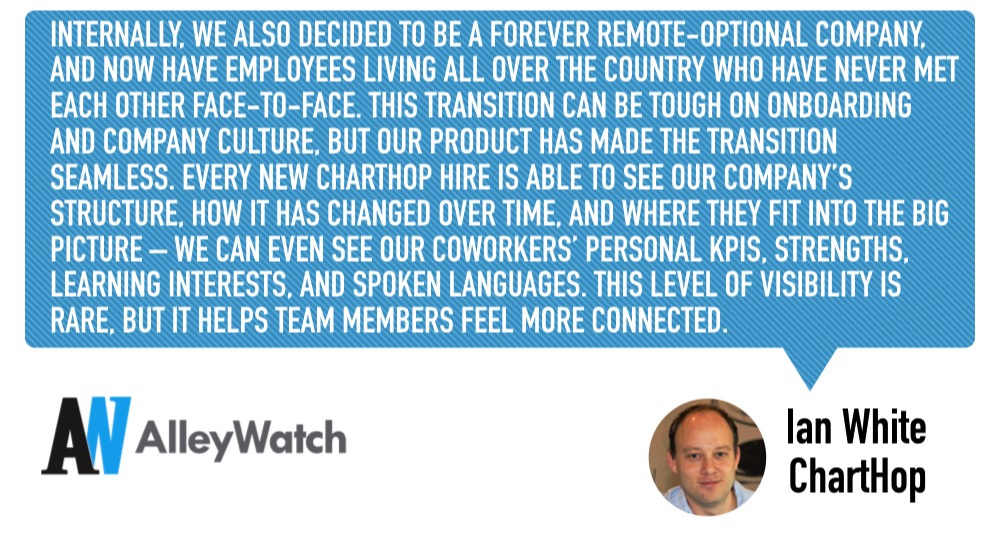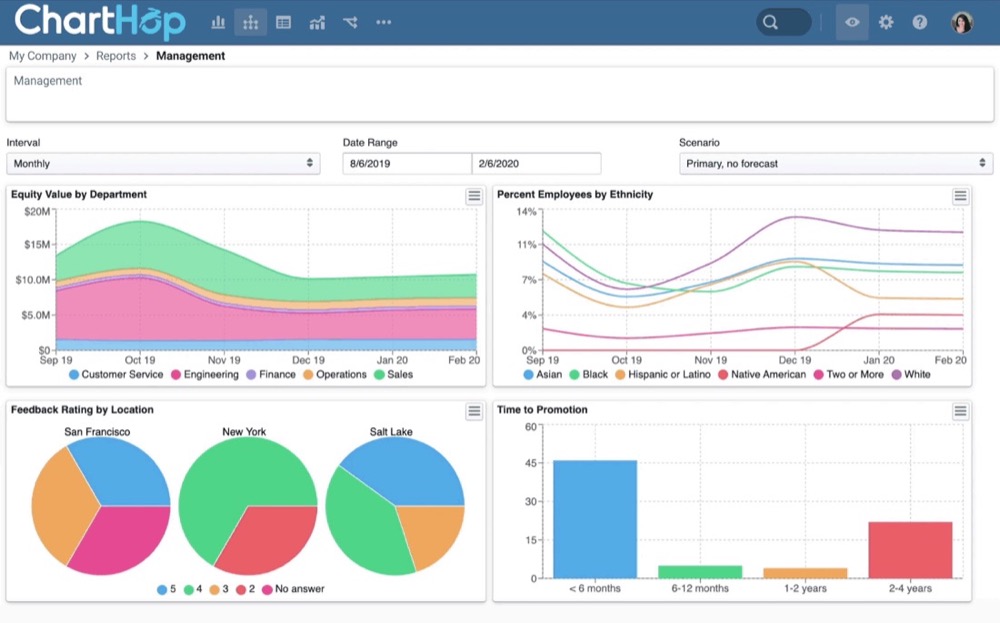According to research conducted by McKinsey in 2017, there are an estimated 8,000 executive transitions at CEO, CEO-minus-one, or CEO-minus-two level every year in Fortune 500 companies and 40% of these transitions are deemed unsuccessful over time. Organizational management is something that companies struggle with at every level, whether it’s a Fortune 500 company or a scaling startup. ChartHop is the first-of-its-kind work management platform that provides organizations and leaders with an unprecedented insight into its talent pool at all levels. Leaders can visualize team composition by building individual talent profiles that include information on compensation, gender, race, ethnicity, languages, Myers Briggs score, and more. Armed with this information like never before, scaling organizations can easily focus on DE&I (Diversity, Equity, and Inclusion) initiatives and make more informed decisions regarding promotions, compensation structure, and more.
AlleyWatch caught up with CEO/CTO and Founder Ian White to learn more about ChartHop’s impressive traction, future plans, and recent funding round, which brings the total funding raised to $19M.
Who were your investors and how much did you raise?
We raised $14M Series A financing led by Andreessen Horowitz (a16z) with the support of new and existing investors. This new funding comes only 6 months after we announced our seed in February 2020 as the pandemic and shifts in organizational needs have accelerated our growth.
What’s really cool is this round includes more than 40 founders and C-level executives. Executives have been experiencing the pains of organizational management for decades and their support shows just how relatable the problem we’re solving is.
We’re also grateful to have the support of some great NY-based firms focused on worktech/future of work, and incredible micro-funds with experienced operators including Abstract Ventures, Basement Fund, CoFound Partners, Company Ventures, Cowboy Ventures, Cultural Leadership Fund, Flybridge Capital, Ride Ventures, the Todd and Rahul Angel Fund, Tokyo Black, SemperVirens, Shrug Capital, and Work Life Ventures.
 Tell us about the product or service that ChartHop offers.
Tell us about the product or service that ChartHop offers.
ChartHop solves the broken, manual, and time-consuming organizational management processes by surfacing and visualizing the people data leaders need to effectively manage their organization, such as location, gender, salary, stock grants, number of direct reports, etc. This way, leaders can make data-informed decisions on a day-to-day basis and plan for the future, with context.
ChartHop also gives every employee visibility into how they fit into the organization’s goals and makes cross-functional collaboration easier than ever before.
What inspired the start of ChartHop?
I founded ChartHop in 2018 because I realized that there is a great software for almost every aspect of business except a company’s most valuable asset: its people.
Before founding ChartHop, I was the cofounder of Sailthru and the first head of engineering at Business Insider. At both organizations, I witnessed how much of a chore organizational management was and the challenges (i.e. manual spreadsheets) that came with it when a company scaled.
When we reached 50 people at Sailthru, our early processes started to break down. We needed to set up a robust team structure, to make promotion decisions, to ensure compensation was fair & equitable – yet couldn’t find a good tool to do so.
I decided to build a platform that gives leaders a complete and real-time view of their workforce, which ultimately replaces the webs of spreadsheets and empowers teams to better understand their organization and make more informed decisions.
How is ChartHop different?
There simply isn’t another platform that provides a comprehensive view of an organization the way ChartHop does. While there are companies that operate in adjacent spaces, their focus is more on collecting and storing data, while we’re about bringing it to life and making it something customers can leverage to transform their organizations and engage in efficient, data-based decision-making.
The new funding also allows us to accelerate our offering, which helps companies build a strong foundation rooted in equality by visualizing team composition, compensation, new hires, performance reviews, and more, across any dimension, such as gender, race/ethnicity, veteran status, LGBTQIA+, etc. DE&I initiatives should be an integral part of planning from day one and not something companies audit once a year, so we’re making this a part of our base package.
What market does ChartHop target and how big is it?
Any company looking for a better way to run and scale would benefit from using ChartHop. We work with organizations that range from 100 to thousands of employees in the US and globally. While the head of HR is a primary user amongst our early customers, we’re solving a problem that goes beyond HR — it’s for any executive, leader, or manager in any organization that’s growing and needs to plan the organization in a more informed, strategic way.
What’s your business model?
ChartHop is a SaaS per employee subscription model.
How has COVID-19 impacted the business?
Technology has long failed the strategic needs of people leaders, but 2020 has really exposed the damage. With businesses under more scrutiny than ever before – from supporting remote teams amidst economic crisis to championing equality following nationwide protests – all eyes are turning to HR as teams race to update hiring plans, report diversity numbers, and rethink the way organizations should be structured in our new remote work world. All of this makes ChartHop’s products even more essential, and that’s evident in our growth. We’ve seen 10x growth since raising our seed.
Internally, we also decided to be a forever remote-optional company, and now have employees living all over the country who have never met each other face-to-face. This transition can be tough on onboarding and company culture, but our product has made the transition seamless. Every new ChartHop hire is able to see our company’s structure, how it has changed over time, and where they fit into the big picture – we can even see our coworkers’ personal KPIs, strengths, learning interests, and spoken languages. This level of visibility is rare, but it helps team members feel more connected.
What was the funding process like?
After David Ulevitch, general partner at Andreessen Horowitz (a16z) led our seed round, he was able to see first-hand the impact the ChartHop product was having and the growth we were experiencing. As the effects of COVID on the business were unfolding – growth was accelerating as many of the pain points ChartHop solves became more pronounced with the rise of remote work and the demand for building more diverse teams – we discussed how a Series A would allow us to get the product in customers’ hands even faster.
Conversations moved quickly; I presented our pitch deck to the a16z partners and opened the round to other executives who I knew loved our product. The process was seamless, and I’m grateful to have such a smart and supportive team of investors behind me.
What are the biggest challenges that you faced while raising capital?
With so many fantastic seed funds, micro funds, and angels who can add tremendous value, it was difficult to strike a balance between them all. I can’t thank a16z enough for being supportive through this process since our seed round in February, but we were definitely oversubscribed at one point. We had to make tough decisions, but in the end, we were fortunate enough to bring on an excellent group of investors. It’s great to be excited about the people you’re working with.
What factors about your business led your investors to write the check?
ChartHop is solving an incredibly relatable problem. When I show investors or other executives our product, they get excited because they know firsthand how painful and time-consuming organizational management is. They wish they would have had our product years ago and understand how essential our technology will be for scaling businesses.
What are the milestones you plan to achieve in the next six months?
Right now, we’re hyper-focused on growing our team and building an amazing user experience with more customization and product features. We already have integrations with platforms like Greenhouse, Workday, Slack, and BambooHR, but we’re focused on expanding that work so ChartHop can become the one true source for workforce information.
We’re also doing a lot of work around compensation planning. Because ChartHop centralizes demographic, performance, and benchmark data, customers can be much more intentional about both cash and equity compensation and address potential pay gaps, before they occur.
It’s incredibly powerful to see a team’s proposed compensation & promotion changes and being able to adjust any unconscious biases before changes go into effect. We believe this will have a huge impact in how companies make decisions and will help address some of the wider compensation inequalities issues we’ve seen in the space.
It’s incredibly powerful to see a team’s proposed compensation & promotion changes and being able to adjust any unconscious biases before changes go into effect. We believe this will have a huge impact in how companies make decisions and will help address some of the wider compensation inequalities issues we’ve seen in the space.
What advice can you offer companies in New York that do not have a fresh injection of capital in the bank?
Economic uncertainty is prompting many founders to think about ways to cut costs but adopting a location-based compensation model amidst the new WFH normal is not the way to do it. Whether you are a team of 10 or 300, reducing salaries for employees who move away from New York isn’t worth the damage you’ll do to team culture and morale. Culture impacts every part of a business, so protecting it should be a founder’s number one concern.
What’s your favorite outdoor dining restaurant in NYC?
Since the pandemic started my wife, son, and I have been bouncing around outside of the city, but the NYC restaurant I’ve most missed this summer is Lilia from my old neighborhood in Williamsburg.
You are seconds away from signing up for the hottest list in New York Tech! Join the millions and keep up with the stories shaping entrepreneurship. Sign up today






